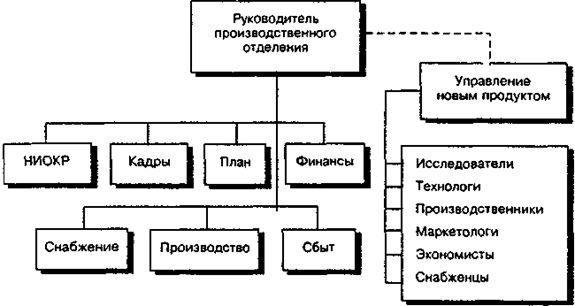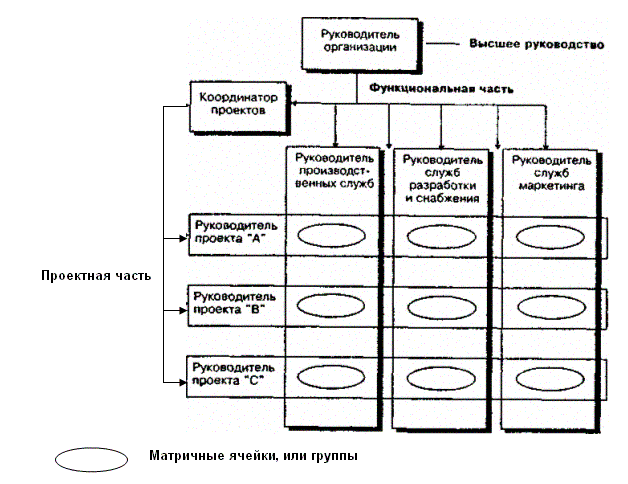home
 Management Management
 Management - Vikhanskiy OS Management - Vikhanskiy OS
|
Management - Vikhanskiy OS
2.3. Matrix Organization
To a certain extent, the drawbacks of the divisional scheme were resolved in practice with the transition to organizations built with the inclusion of elements of the matrix scheme: project management, temporary target groups, permanent complex groups. The matrix scheme is simply not feasible within the framework of the mechanistic approach. It requires a transition to an organic approach that provides great opportunities in the design of horizontal, informal and indirect links, which are largely attributes of the matrix organization.
Elements of matrix organization , and in some cases matrix departmentalization in general, were first used, as experts say, in the electronics industry and in other industries with so-called high technology. In the conditions of transition from national to acute international competition, it became necessary to create an organizational structure that would allow for rapid technological changes based on the most effective use of highly skilled labor. If General Motors and the automotive industry were the ancestors of the divisional structure, then IBM and computer production have the primacy in the wide use in practice of the matrix structure and its elements.
To solve large-scale and complex tasks of integrating various types of activities in the organization, it was necessary to create a greater number of communication channels and decision-making centers. To do this, different coordination elements were used: special coordinators, target and complex teams, autonomous groups, product or project managers, career planning, information networks, in-house entrepreneurship, etc. Matrix organizational structures are difficult to implement. However, they are much more than the previously used scheme, they respond to changes in the society.
For example, in the company of IBM there are people, of whom there is glory, that they can all and which are called "fixers". This is a long time working in the company experienced and with great contacts specialists who without any formalities are in the "focus" of solving problems related to the sphere of consideration of top management. In some areas of the company's work, the ficer functions are formalized, and they are appointed by the project managers,
Programs and are responsible at the same time for resources and communications, but not for cadres. They may not have subordinates, but they have broad powers.
The active use of various semi- autonomous groups or collectives is an important part of the matrix structure. These groups are created under the goal or under the project to solve a specific problem and enjoy a certain freedom in organizing their work (Figure 8.4).

Fig. 8.4. Schematic diagram of a semi-autonomous working group for the development of new products
They can independently acquire the received resources and distribute the received products, determine everything that relates to the organization of labor, the quality of the products, the maintenance of equipment, the implementation of changes, the hiring and sometimes the choice of a manager. The presence of such groups allows you to simplify the hierarchy in the organization and make the structure more dynamic. It is believed that it is necessary to conduct more experiments in this area in order to achieve optimal results. Best practices in this area in the form of integrated production teams are available at Volvo plants, which collect the "truck" method from the beginning to the end, from placing orders for parts and components among suppliers and to selling a car to a specific customer. All calculations with suppliers and the plant brigade leads from the earned means, and divides the difference between employees.
Creation of target groups and other groups in practice is rarely associated with placing them in the organization's structural diagrams, as shown in Fig. 8.4. Due to their temporal nature and high degree of dynamism, these groups are often not included in formal structures. An important condition for the effective use of groups in the organization is the availability of managers' special knowledge and skills in the field of human resources management.
When organizing group work, it is important to consider the following. First, it is necessary to clearly define the scope of activities in the organization, to which the rights and responsibilities of the group will be distributed. Since the group is usually given the right to plan and implement its actions, this significantly reduces the possibility of interference in its activities of functional or line managers. In addition, this approach allows to enrich the work of the group and motivates employees. Secondly, group work realizes itself best when the group is formed for tasks that "intersect" the lines of functional and linear leadership.
The use of groups as an element of the matrix construction of the organization has also negative aspects. Such groups, for example, are not sustainable entities. Intensive use of groups deprives workers of their place in the "organizational building", people constantly move from group to group and the whole organization becomes, therefore, as temporary.
If the organization increasingly resorts to the use of different kinds of groups, then there comes a time when it is necessary to go completely to the matrix organization. In this case, it is possible to reduce the negative effect of the group approach. For example, frequent changes in managers and specialists in groups and projects lead to loss of control, and the organization may simply collapse.
Matrix organizations are created when the chosen strategy focuses on obtaining a high-quality result for a large number of high-tech projects, and the work itself is very complex and the disadvantages generated by the use of groups outweigh the benefits. So, for example, a similar situation took place in the USA in the 60s. In the aerospace industry, actively subsidized at that time by the government. The government showed not only high demands on the quality of projects financed and the timing of their implementation, but also no less high requirements for the expenditure of funds received by companies under these projects. In such a situation, the companies had no other choice but to move to the matrix schemes of organizational structures.
As noted above, matrix departmentalization is always a combination of two organizational alternatives, usually functional and product (design). Thus, two formal schemes of structures appear in the matrix organization (Figure 8.5). The main task of the leadership in these conditions is to maintain a balance between the two structures.

Fig. 8 5 Schematic diagram of the matrix organization
The imbalance in the combination of the two organizational principles within the framework of the matrix scheme creates a number of problems. S. Davis and P. Lawrence define these problems and ways of resolving them as follows (Table 8.2).
Summarizing the characteristics that distinguish a well-designed matrix organization, it is important to note the following. In this type of organization, top management determines the rights and responsibilities of both parts of the organization - functional and product (project). Conflicts are inherent in the matrix scheme and their occurrence should not be a surprise. To do this, it is necessary to develop plans and measures for resolving conflicts. Important in this regard is the training of personnel for working in groups. The top management should act as an arbiter in conflicts between parts of the organization. General planning should be aimed at minimizing the uncertainty in the activity of matrix cells. This is facilitated by the fact that the project part of the matrix organization is used to establish goals, form plans and project budgets, and the functional part provides these elements of the project organization with the necessary resources. That is, what needs to be done within the framework of the project and how this should be done can be clearly divided between the specified parts of the matrix organization.
Table 8 2.
Problems arising in matrix organizations, the causes and ways to eliminate them
Causes and ways of their elimination |
|
The tendency towards anarchy |
The rights and responsibilities between the two parts of the matrix structure are unclear. Clarity is needed on this issue |
The struggle for power |
Clearly not defined power authority. It is necessary to balance the relationship between functional and project managers |
Development group |
It becomes the norm to make all decisions in the group. It is necessary to change the policy of leadership and to introduce motivation for individual efforts |
The collapse in the general economic crisis |
Matrix cells (or groups) are not very decisive in the period of deterioration in the overall situation. The need for senior management assistance in strategy and planning |
High overheads |
It takes more money to keep a large number of managers. Assign fewer leaders to the multiplicity of roles in the organization |
The gap between the upper and lower levels |
The lower links work on the matrix scheme, and the "tops" do not use it. It is necessary to maintain a small size of matrices in order to involve top management |
Lack of control by levels |
Matrices exist at every level and the system becomes complex. It is necessary to identify critical centers in the organization and around them to create matrices |
Narcissism |
The organization closes in itself The top management must constantly pay attention to critical activities - goals |
Difficulties in making decisions |
Decisions are not accepted on time. It is necessary to delegate decision-making to lower levels of management, i.e. To where they are implemented |


Comments
When commenting on, remember that the content and tone of your message can hurt the feelings of real people, show respect and tolerance to your interlocutors even if you do not share their opinion, your behavior in the conditions of freedom of expression and anonymity provided by the Internet, changes Not only virtual, but also the real world. All comments are hidden from the index, spam is controlled.